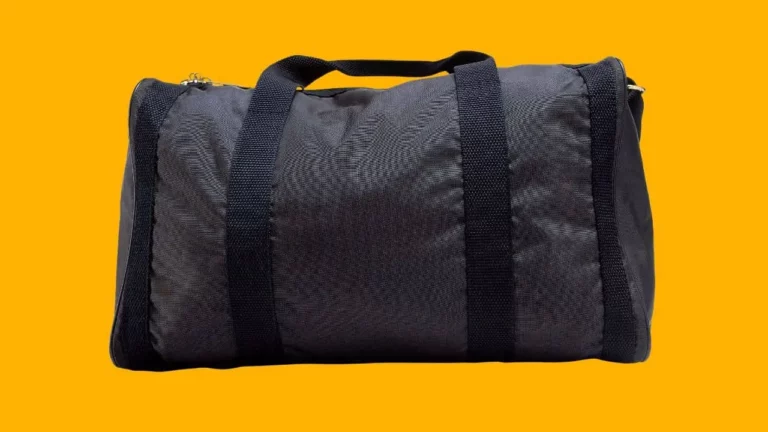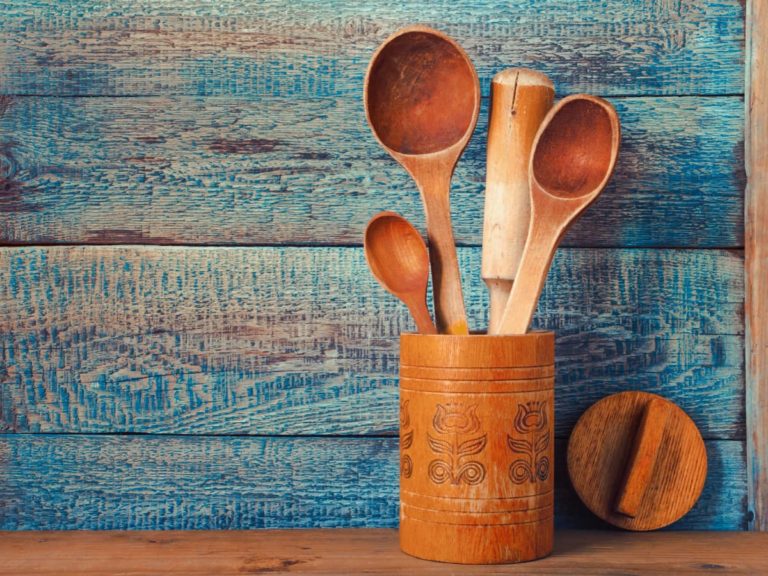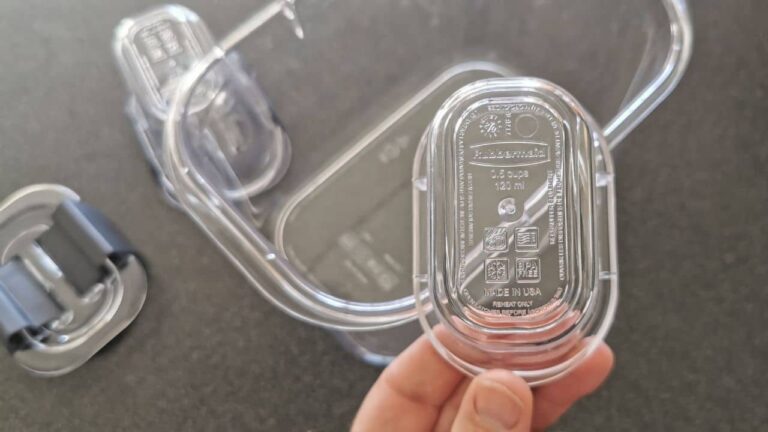Is It Safe To Store Food In Stainless Steel Containers? (Solved)
Curious about the safety of storing food in stainless steel containers? Put your worries to rest!
Storing food in stainless steel containers is not only safe, but it’s also highly beneficial. Known for its durability and resistance to rust, stainless steel is a safe, odor-resistant, and nearly indestructible material that retains heat and cold effectively. It’s fully recyclable and proficient at maintaining the freshness of your food.
In this piece, I’m going to delve deep into the world of stainless steel, covering everything from its top five benefits to the range of food-grade options available. I’ll also discuss its suitability for hot and cold food storage and offer some practical tips on how to clean it.
Are you ready to discover the wonders of stainless steel for food storage? Let’s dive in!
5 Reasons and Hygienic Benefits Why It’s Safe To Store Food in Stainless Steel
Do you know stainless steel is over 100 years old? The first Stainless Steel was invented back in 1913 in Sheffield, UK.
Unlike pure raw metals, stainless steels mix metals such as chromium, molybdenum, iron, and sometimes nickel.
Let’s look at its economic, health, and hygienic benefits.
#1 Doesn’t react or leach with food
Firstly, SS is neutral and inert. That is, they don’t leach chemicals into your food like plastic.
Moreover, you don’t have to worry about odors and stains with rustless steel. Why? That’s because SS is a non-porous alloy. Hence, it’s widely used in professional kitchens and hospitals.
Rustless steel is also inert to alkalis and acids that can sometimes be produced by certain foods and vegetables, unlike plastic containers.
What about storing tomato sauce?
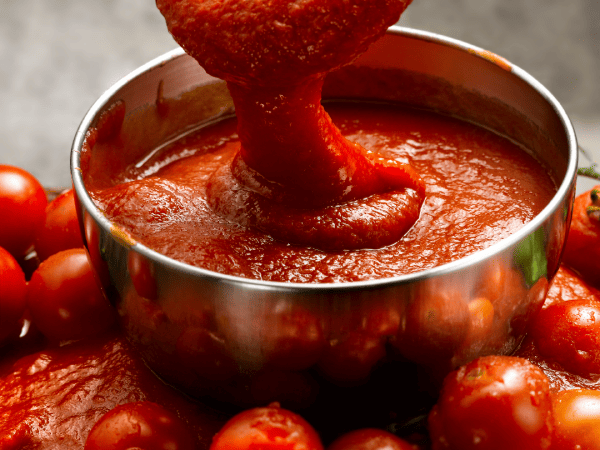
As SS is inert to alkalis and acids found in meat, milk, raw vegetables, and cooked foods, you don’t have to worry about storing tomato sauce in these containers. Comparatively, plastic containers leach 55x faster!
#2 Locks freshness
Want a food storage box that can seal away the freshness? Go for SS with an airtight lid!
Stainless steel even retains heat, thanks to its high thermal inertia. Hence, you can expect it to offer lasting hotness and coldness to your food. As a result, your food lasts longer. Moreover, SS can prevent decay in food and, in turn, wastage.
#3 Durable and recyclable
SS containers don’t warp, break, or crack, unlike glass or ceramic. Conversely, plastic materials break down every time you wash them. Hence, rustless steel is a low-maintenance material for storing food.
While aluminum starts pitting quickly, stainless steel guarantees years of use, thus saving money in the long run.
Besides being completely recyclable, SS is also 100% reusable, much like aluminum. To put that into perspective, 75% of SS products and aluminum tin cans made a century ago are still in use!
#4 Safe
Another reason to stick to SS for safety is its resistance to rust and corrosion, unlike cast iron. The best thing is the coating on SS repairs itself with oxygen.
Is it also safe to store food in stainless steel pots?
Yes, it’s safe to store your food in SS pots because it’s anti-bacterial. Moreover, viruses can’t survive on their surface for more than a few hours due to their smoothness.
Are they dishwasher safe?
Yes, SS food containers are safe to use in dishwashers. However, you must first make sure the handles are safe as well!
#5 Popularity: Why is Kourtney Kardashian obsessed with stainless steel containers?

Apart from using premium water bottles, Kourtney Kardashian also uses nothing but SS plates, pots, and glasses for kids.
Her reasons? Absence of BPA and phthalates in rustless steel.
She prefers SS more than all the other options “because it’s durable, more hygienic, and doesn’t contain chemicals. We even use reusable stainless steel straws instead of wasting disposable plastic ones“.
Types of Stainless Steel To Store Food in
Everything from cookware to utensils, cutlery, and appliances, SS is used for a wide range of things in kitchens and hospitals today.
However, stainless steel is a mix of different metals. Hence, not every piece of SS is made the same or used in the food industry.
Let’s look at the ones you can use in the kitchen next.
What type of stainless steel is food-grade?
| Grading | Effects and traits |
|---|---|
| 200 | Used for food canisters, this is a low-quality SS that’s not entirely rust-resistant. |
| 304 | From appliances to utensils, flatware, and even storage bins, SS is the most commonly used material in most kitchens. It’s vibrant with a mix of nickel and chromium that makes it resistant to corrosion, except against salt. It’s also known as 18/8. |
| 316 | Kitchen cookware, hibachi grills, and equipment in professional kitchens are made from SS 316. That’s because it’s corrosion-resistant against everything found in kitchens, including salt. |
| 430 | Usually found in flatware and professional prep tables, 430 is the magnetic type of SS made with a mix of nickel and not entirely resistant to rust. |
| 440 | You’ll find 440 SS in professional knives, flatware, cutlery, and even on your oven handle as it’s the most powerful type. They’re also resistant to corrosion and ravages of time. |
What do international regulations say about using stainless steel for food?
You can use stainless steel for food no matter where you are, unlike aluminum or red porcelain.
In Europe, EC 1935/2004 specifies safety, leaching, and taste/color changes for containers used for food. Moreover, the Council of Europe updated their guidelines for food-safe containers in 2013 to include a new test to check against reactions with citric acid.
Besides, the FDA has approved 304 SS owing to its compliant chromium content in the U.S.
Can You Keep Hot Food in Stainless Steel Container?
Yes. SS containers actually function as a hot case when you add food. In short, the container will retain and heat up to keep your food warm sans any harm or damage. That’s why it has been the most common lunch box in India for ages. Win-win, right?
Can You Freeze Food in Stainless Steel?
Yes. Whether it’s an SS pan, pot, tiffin box, or canister, you can put them in the freezer without worrying about warping, cracking, or breaking. SS is safe in the freezer as it doesn’t crack under low temperatures.
Moreover, you can also thaw food from rustless steel food boxes quickly.
How Do You Clean Stainless Steel Cookware? Dos and Don’ts

SS isn’t just easy to clean but also simple to disinfect. Additionally, it’s low-maintenance compared to all the other materials.
However, there are a few things to keep in mind while you’re at it.
5 Effective cleaning products for stainless steel
- Use warm water to remove grease.
- Try lukewarm soapy water to remove oil.
- Diluted vinegar can eliminate limescale that forms due to years of negligence.
- Remove residues of tea and spices with baking soda and boiling water with up to 15 minutes of soaking.
- Acetone and other alcoholic cleaners will eliminate glue residues quickly.
5 Cleaning products to avoid with stainless steel!
- Highly concentrated bleaches can aggravate corrosion and lead to pitting.
- Pitting-based corrosion also worsens with cleaning products that use chlorides and salts.
- Using abrasive materials:
- Wire wool and iron scrubs can leave scratch marks on rustless steel.
- They can destroy the passive film coating on the surface of SS containers, exacerbating corrosion.
- Scoring powders can be equally harmful to the passive layer on SS products.
- Don’t use silver dip cleaners because they contain chlorides and extremely strong acids.

Useful Information About Stainless Steel You Need To Know
Before you fully commit to SS products in the kitchen, keep the following things in mind.
Stainless Steel for food and drinks
Food and drinks are safe to prepare and store in stainless steel containers in professional kitchens and homes. SS can last a long time without harm or damage being an inert material.
Stainless Steel for healthcare
SS containers, appliances, parts, and products are easy to disinfect, sanitize, and sterilize (thermal and chemical). Hence, they take no time to maintain.
As a result, they prevent cross-contamination essential in healthcare. That’s also because the SS surface is smooth, non-porous, and resistant to bacteria, microorganisms, and viruses.
Moreover, SS is highly resistant to natural wear and tear, increasing its life span.
Stainless Steel Family
There are four main categories of the rustless steel family of materials. Take a look at their characteristics:
| Martensitics | Ferritics | Duplex Grades | Austenitics |
| High Strength Reasonable ductility Hardenable by heat treatment Modest corrosion resistance | Reasonable ductility & corrosion resistance Resistant to SCC (stress corrosion cracking) | High strength Good to excellent corrosion resistance Good ductility down to 58°F (-50°C) Good fatigue strength | Good strength & highly formable Hygienic due to good to excellent corrosion resistance Excellent ductility even at very low temperatures |
Comparative material attribute
I’ve compared the complete set of traits for four types of stainless steel and their attributes against aluminum below.
| Attribute | Austenitic Stainless | Ferritic Stainless | Duplex Stainless | Carbon Steel S355 | Aluminium AI6061 |
|---|---|---|---|---|---|
| Yield Strength | Mid Range | Mid Range | Strong | Strong | Mid Range |
| Highly Hygienic | Strong | Mid Range | Strong | Weak | Mid Range |
| Weldability | Strong | Mid Range | Strong | Strong | Strong |
| Lifetime Appearance | Strong | Strong | Strong | Weak | Strong |
| Energy Absorp’n | Strong | Weak | Strong | Mid Range | Weak |
| Fire Resistance | Strong | Strong | Strong | Strong | Weak |
| Service Life | Strong | Mid Range | Strong | Weak | Mid Range |
| Life Cycle Cost | Strong | Mid Range | Strong | Weak | Mid Range |
| Life Cycle Emissions | Strong | Mid Range | Strong | Mid Range | Mid Range |
Healthcare-related infections of stainless steel vs. others
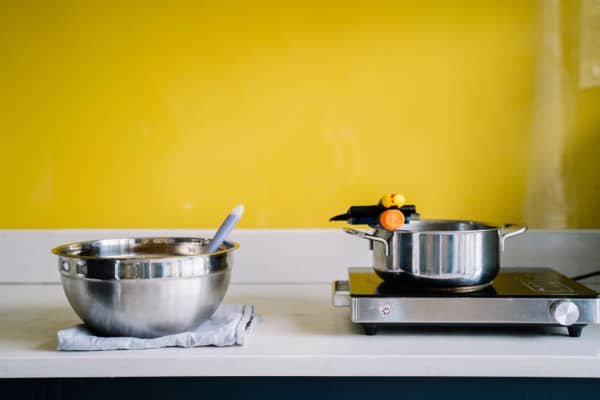
When it comes to health and hygiene, several factors affect food containers. Let’s take a look at it:
| Material | Antimicrobial Surfaces | Silver-Containing Coatings | Copper & its Alloys | Stainless Steel |
|---|---|---|---|---|
| Initial Effectiveness | Reasonable 🟠 | Very Good 🟢 | Very Good 🟢 | Very Good 🟢 |
| Later Effectiveness | Reasonable 🟠 | Poor 🔴 | Reasonable 🟠 | Very Good 🟢 |
| Explanation | Not effective against all micro-organisms. Generally, only inhibit micro-organism growth. Surface performance diminishes rather quickly with regular use. | Coating wears off and no visible identifiers of failure. Known weaker performance against viruses. | Release of Copper ions diminishes over time as surfaces oxidizes. Less effective against resistance forming bacteria, eg; E-Coli. | Completely inert and passive. Hard smooth surface. Self-repairing passive film. No deterioration over time (at least 100 years). |
| Life Cycle Cost | High 🔴 | Very High 🔴 | High 🔴 | Good 🟢 |
| Wear Resistance | Poor 🔴 | Poor 🔴 | Reasonable 🟠 | Very Good 🟢 |
Why Start Using Stainless Steel For Food Storage Right Away!
We’ve explored the many compelling reasons why stainless steel (SS) emerges as the top contender in food storage solutions. Its exceptional hygiene and health benefits, coupled with unbeatable durability, make it a wise choice for any kitchen.
Further, it creates a formidable barrier against bacteria and viruses, safeguarding your food from contamination, and it is resistant to rust, ensuring long-lasting usability.
Not only does it boast these remarkable benefits, but it also comes with a surprisingly affordable price tag. Yes, quality and cost-effectiveness can indeed go hand in hand!
The single caveat when it comes to stainless steel is its non-compatibility with microwave usage, as it could potentially cause fire hazards. However, considering the myriad of benefits, this minor inconvenience can be easily managed with a bit of mindful cooking.
So, isn’t it time you embraced the change? Switch to stainless steel food storage solutions today, and step into a healthier, more durable future of food preparation and preservation. Your kitchen, and ultimately your wellbeing, will thank you for it!
Sources
- California State Science Fair: Steel Stays Hot While Other Metals Do Not
- CRISTEL: Official Website





